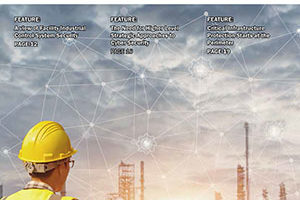Category: Power/Energy/Oil & Gas sector
Power/Energy/Oil & Gas sector
Croatia hit by multiple earthquakes affecting infrastructure and homes
Asia-Pacific resolves to move from crisis to resilience
Latest issue of World Security Report has arrived

SAFECOM and NCSWIC Address Communications Dependencies on Non-Agency Infrastructure
NCSC Update Guidance on Principles for the design and build of in-house Public Key Infrastructure (PKI)
November is CIPR Month in US
Hurricane Zeta makes landfall on Louisiana Coast
UAE Cultivates the First Private Sector Alliance for Disaster Resilient Societies (ARISE) in the Arab Region
While the globe is facing challenging times and rapid changes due to disasters and the need to create risk-resilient societies is inevitable, the United Arab Emirates is leading the private sector engagement for disaster risk reduction by announcing the first ARISE initiative in the Arab region to achieve the outcomes and goals of the Sendai Framework in a transparent and inclusive way that delivers measurable impact.
This initiative is in conjunction with the United Nations Office for Disaster Risk Reduction (UNDRR) that works towards a resilient, prosperous future where fewer lives are lost to disasters, capital assets and investments are risk-informed, and infrastructure is resilient to natural and man-made hazards and advocates for risk-informed development by encouraging and supporting the private and public sectors to put in place policies and practices to reduce disaster risk and losses.
The UAE Private Sector Alliance for Disaster Resilient Societies (ARISE) kicked off yesterday with its first meeting at Burj Khalifa led by Mr. Sujit Mohanty the Chief of UNDRR Regional Office for the Arab States (ROAS), Dr. Mahmoud Al Burai the Vice President of International Real Estate Federation and Senior Advisor in Dubai Government, along with the United Nations Resident Coordinator for the UAE Dr. Dena Assaf and other senior officials from UNDRR.
The meeting was attended by Dr. Tariq Ahmed Nizami, Founder & CEO of CEO Clubs Network, Dr. Assad Farah, Dean School of Business Administration at American University in Dubai, Helen Chen CEO and Co-founder of Nomad Homes, Chris Roberts, CEO of Eltizam Asset Management Group, Mohammed Alsharaf, COO of Eltizam Asset Management Group, Mr. Fadi Nwilati, CEO of KAIZEN Asset Management, Mr. Ghassan Farouk Afiouni Managing Partner and Inventor MPI, Mr. Ahmed Riad, Managing Director Estmrarya Consulting, Dr. Raza Siddiqui, CEO Arabian Health Group and Zeina Abou Chaaban the Managing Parter of Palestyle.
“Today we are witnessing a remarkable movement convened by the UAE private sector to establish the first national ARISE in the Arab region and set the roadmap for other Arab countries. COVID19 has put a stark reminder to all of us that reducing risk of disasters whether natural, man-made or biological, has to be everyone’s business. This initiative will capitalize on the UAE private sector to promote risk-informed investments and to engage in business practices that build resilience and prevent new risks from being created” said Mr. Mohanty, Chief of UNDRR ROAS.
Dr. Mahmoud Burai said: “This initiative showcases the UAE leadership in founding a strong platform for the private sector to support and implement the Sendai Framework for Disaster Risk Reduction 2015 – 2030 and its commitment towards 2030 Agenda for Sustainable Development, Paris Climate Agreement, New Urban Agenda and Agenda for Humanity. UAE ARISE will work closely with Dubai Police who is leading on Dubai Resilient and other local and federal governments to create risk-resilient societies by energizing the private sector in collaboration with the public sector and other stakeholders to achieve the outcomes and goals of the Sendai Framework in a transparent and inclusive way that delivers measurable impact.”
The United Nations Resident Coordinator for the UAE Dr. Dena Assaf said: “The United Nations has been working for the last 75 years around many global challenges, bringing awareness and progress across the planet and the UAE has always been a bastion of hope and resolve in the region. The UAE private sector’s role and engagement in disaster risk reduction not only ensures a more resilient and prepared society, but also enables accelerated progress towards the Sustainable Development Goals”. Dr. Dena Assaf encouraged the members to contribute to the UN global conversation on the World We Want, and take the survey at www.UN75.online.
The first meeting agenda unfolded the UAE ARISE objectives, structure, voluntary action commitments and the workplan 2020-2021, while the board election announced HE Dr. Mahmoud Al Burai the Chair of the UAE ARISE, Co- Chair, Mr Ahmed Riad and the Vice Chair, Dr. Tariq Nizami.
Findings on Changing Risk and Building Codes
The Findings on Changing Risk and Building Codes statement outlines the work to be undertaken by the members of the Global Resiliency Dialogue, including:
-Identifying strategies for the identification of future risks and the development of building code solutions that support adaptation to those risks
-Cooperating on the development of international building resilience guidelines and further exploration of the relationship with land use planning instruments that help determine the location of buildings
-Supporting research initiatives to better understand climate science, to assist in aligning expectations for building durability and resilience with the projection of future hazards
-Developing and deploying messages and resources that enhance understanding of building codes, support a common understanding of risk, and communicate the importance of up-to-date building codes
-Advancing risk and impact analysis to recognize the multiple economic and social benefits provided by resilience investments and the desirability of alternative approaches that fully capture the benefits and costs provided by the building codes
Building Code Development/Research Organization Signatories:
- Australian Building Codes Board
- International Code Council
- National Research Council Canada
- Ministry of Business, Innovation, and Employment (New Zealand)
Download Findings on Changing Risk and Building Codes
Source - International Code Council (ICC)

